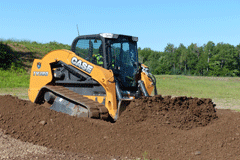var addthis_product = ‘wpp-262’;
var addthis_config = {“data_track_clickback”:false,”data_track_addressbar”:false};if (typeof(addthis_share) == “undefined”){ addthis_share = [];}
Successful skid steer loader and compact track loader (CTL) operation depends largely on the type of terrain you are operating on. For example, concrete, asphalt and rocky surfaces are typically best suited to skid steers, while softer, more sensitive surfaces are better suited for compact track loaders.
But a closer look at attachment use with CTLs sheds more light on specific applications that are best suited for use with tracked machines. Landscapers, residential contractors, and certain utility and agricultural users will benefit from the low ground pressure and stability afforded by CTLs. In this article we’ll look at specific applications and attachment combinations best suited for these machines.
Applications and attachments not suited for CTL use
While CTLs can operate effectively on rocky ground and “improved surfaces” such as asphalt, concrete and paver stones, these surfaces significantly shorten the lifespan of tracks. As such, the use of asphalt-related attachments, such as rock saws and cold planers, is not recommended. In addition to the abrasion of the surface to the tracks, the vibrations of the attachments also vibrate the tracks, further creating friction and speeding deterioration on improved surfaces. It is always a wise choice to use a wheeled machine when using attachments designed for use on improved surfaces.
Good application #1: lifting with forks
Many wheeled skid steer operators have been in a position on rough terrain where they lift a load on to a truck or other surface and the machine “porpoises” – that unsteady action where the machine pivots with the weight of the load and a wheel or two leave the ground. The main advantage: there is no compression of the front tires, and any associated distribution of weight to the rear. This allows the operator to lift and operate with greater confidence. This is further improved when operating a CTL with a vertical lift arm design, which lifts the load in such a way that evenly distributes the weight of that load throughout the machine. These principles apply equally to those in farm and ranch applications with attachments such as bale spears and bale forks (see picture). A general rule could be made that any application that required lifting and articulating a load on a soft and uneven surface would be best suited for CTLs.
Good application #2: dozer blades
As CTLs feature an undercarriage that is similar to that of a compact dozer, it would only make sense that it would have certain advantages in grading applications, and be more practical and versatile for some landscapers to own compared to a compact dozer. CTLs also offer more surface contact with the ground and greater stability and weight distribution compared to skid steers, which makes it safer to operate on slopes. The tracks also create a solid platform to operate on. Instead of four individual points of contact as provided by skid steer tires, the tracked machine provides consistency in the blade cutting edge position as the operator moves along a path. Tires tend to roll up and over individual obstacles, which creates up and down movements. Tracks bridge that movement to create a smooth ride. The same principle could be applied to grader attachments.
Good application #3: trenchers
Trenchers are often used to create a trench that causes minimal disruption to the ground immediately around it. These are often dug in finished yards and environments where tire ruts and ripped up grass are undesirable side effects. CTLs provide excellent flotation over the ground so as not to create ruts, and the tracks are not as prone to the spinning and twisting motions that cause tires to rip up grass. CTLs also move the trencher across the ground in an even and stable manner due to the better “platform”, ensuring a uniform and well-dug trench.
Good application #4: Harley Power Box Rakes; preparator landscape grader rakes, auto rakes
One of the best feelings a landscaper gets is when the job is nearly done and all that’s left to do is finish the seed bed preparation, seed the lawn, apply the straw covering and then move on to the next job. These final grade/bed preparation attachments work very well on skid steers, but similar to trenchers, wheeled machines in this application increase the chances of rutting and other soil disturbances that will require the finished bed to be fixed by hand. CTLs run these tools just as well as skid steers and without as much disruption to the final seed bed.
Source: Case Construction